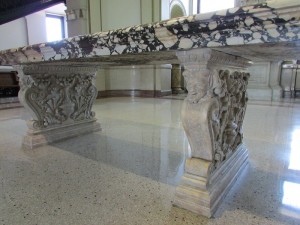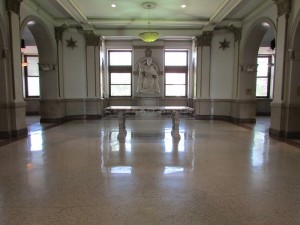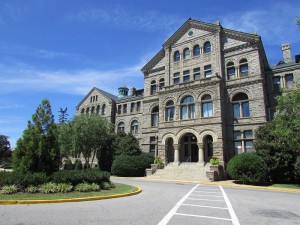
This week’s post is guest authored by Angela Geosits, archives assistant and doctoral student in English.
Any visitor to McMahon Hall is likely familiar with the massive marble table which dominates the central foyer. Set between the two great staircases out of the flow of foot traffic, this stately table blends in with the neutral colors of the space and feels as if it has always been there. But contrary to all expectations, this 2 ½ ton marble table is surprisingly well traveled, and even enjoyed a misspent youth loitering in the lobby of Loew’s Capitol Theatre, the last surviving Broadway vaudeville house. Some traces of this thespian origin can be seen in the detailed carvings of Comedy and Tragedy on the table’s supports.
But how on earth did our table get from a vaudeville theatre in New York City to an academic building at Catholic University in Washington, DC? The story begins in the winter of 1967, when the roof of the Army surplus theater the Drama Department had been using as their performance space collapsed under a heavy load of snow. Enthusiastic fundraising efforts began in order to fill the desperate need for a new stage. CUA Drama alumnus Ed McMahon (no relation to Monsignor James McMahon for whom the building is named) knew the Loews and organized a special benefit for the CUA Drama Department on the last night of performances at the Capitol Theatre.

On September 16, 1968, the Capitol Theatre held an evening of special live performances celebrating the legacy of the theater, and the proceeds of the benefit were donated to the building efforts for the new Center for the Communication Arts at CUA. You might know the end result of the building project better as Hartke Theater. The evening of entertainment featured famous performers including Bob Hope, Jerry Lewis, Johnny Carson, and Florence Henderson, among others, and was followed by a champagne dinner and dance at the nearby Americana Hotel. The wildly successful party went long into the night and even rated an article in the New York Times.

Our table had graced the halls of Capital Theatre from 1919 until it closed in 1968. On the night of the benefit, Fr. Gilbert Hartke spotted the table and thought it would make a lovely addition to the lobby of the new Drama building. Our substantial marble traveler was presented as a gift from the Loews Theater Organization to Fr. Hartke in 1968. The intrepid table never made it into the lobby of the new building; a 2 ½ ton table doesn’t fit just anywhere! For two decades, the table provided a stable surface in the basement of Curley for sorting the mail of the building’s residents. But in 1989, the table returned to public appearances when it was moved to its current home in McMahon Hall during renovations. It now rests under the benevolent but watchful eye of long-term resident, the statue of Pope Leo XIII.
Sources:
Crowther, Bosley. “Old-Time Star-Filled Benefit to Close Capitol Theater Tonight.” New York Times, Sept. 16, 1968, p. 57.
Pietro, Mary Jo Santo. Father Hartke: His Life and Legacy to the American Theater. Washington, DC: CUA Press, 2002.
Gatton, John and Dubeck, Joanne. “Gala Benefit Boosts Drive for Theatre.” The Tower, Sept. 27 1968, p. 8.
“NYC Alumni Organize Benefit for the Center of Communication Arts.” Alumnus, Spring 1968, pp. 14-15.
